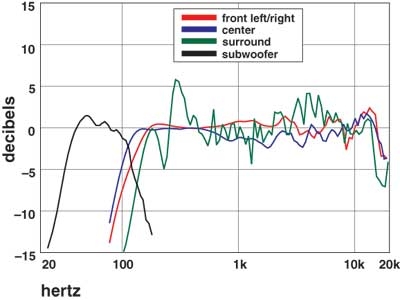Paradigm Cinema 330 Home Theater Speaker System Page 3
TEST BENCH FOR WEB FULL LAB RESULTS: By Tom Nousaine

Frequency response (at 2 meters) front left/right: 125 Hz to 20 kHz ±3.4 dB center: 110 Hz to 18 kHz ±2.3 dB surround: 152 Hz to 14.7 kHz ±5.5 dB subwoofer: 35 Hz to 117 Hz ±2.4 dB
Sensitivity (SPL at 1 meter with 2.8 volts of pink-noise input) front left/right/center: 92 dB. surround: 82 dB.
Impedance (minimum/nominal) front left/right/center: 4.1/9 ohms surround: 4.4/5 ohms
Bass limits (lowest frequency and maximum SPL with limit of 10% distortion at 2 meters in a large room) front left/right/center: 80 Hz at 78 dB surround: 125 Hz at 76 dB subwoofer: 25 Hz at 87 dB SPL 100 dB average SPL from 25 to 62 Hz 106 dB maximum SPL at 62 Hz bandwidth uniformity 94%
All of the curves in the frequency-response graph are weighted to reflect how sound arrives at a listeners ears with normal speaker placement. The curve for the left/right front channels reflects response of a vertically aligned Paradigm Cinema 330 averaged over a ±30º window, with double weight at 30º (the most typical listening angle). The center-channel curve reflects response of a horizontally aligned Cinema 330 averaged over ±45º, with double weight directly on-axis of the primary listener. The surround-channel curve shows the response of the Cinema ADP averaged over ±60º.
When vertically aligned, the Paradigm Cinema 330 has flat response with tightly controlled directivity (meaning that frequency response remains steady over a wide listening area); the most notable deviation was a 3-dB peak centered on 14 kHz. When used horizontally for center channel duty, however, the speaker exhibits "lobing" by the time the microphone is just 15 º off-axis - an effect that's seriously masked by our averaging technique. This suggests that the speaker will sound less transparent for off-center listeners. The ADP surround is a bidirectional speaker and displays the typical highly diffuse sound distribution that is considered optimal for surround speakers.
Bass limit for the UltraCube 10 subwoofer was measured with its crossover set for maximum frequency bandwidth and the speaker placed in the optimal corner of a 7,500-cubic-foot room. In a smaller room users can expect 2 to 3 Hz deeper extension and up to 3 dB higher sound-pressure level (SPL.) Like many modern subs, the UltraCube 10 doesn't reach as high in the frequency range as the crossover dial suggests: the dial tops out at 150 Hz, but the measurements show an upper limit of 117 Hz at half power. SPL capability is somewhat more evenly distributed than for the typical mini-sub - most tend to produce peak volume in the upper part of their bandwidth. The UltraCube 10, however, will produce at least 102 dB SPL at and above 32 Hz at 2 meters. The 40-Hz crossover setting also has an unusual characteristic in that the true crossover frequency at that setting is exactly 40 Hz! At that setting, there's a modest (and very typical) 4-dB dip in SPL at 40 Hz but an additional 10 dB of output at 20 Hz in static measurements - so the speaker actually gets louder at the lower frequency. Even so, maximum SPL capability at 20 Hz with a 40 Hz crossover setting remains a modest 69 dB SPL.








































